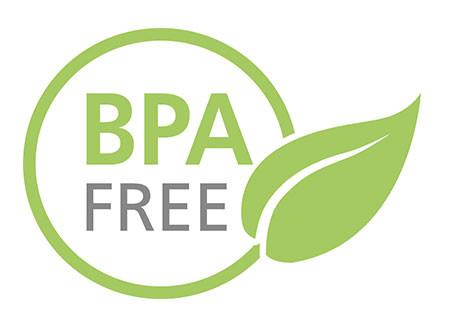It’s on drinking bottles, lunch boxes, diaper packs and on your
new blender spec list: the BPA-Free label. Avoiding BPA is trending now and articles around the Internet are making new-age parents and hip urban go above and beyond to keep their households as BPA-free as possible. But let’s be honest here: as a simple, average consumer you actually have no idea what BPA-free means now, have you? I mean sure, you do know it has something to do with plastic, food safety and that latest Oprah podcast about living a clean, healthy life, but why is it really that important not to have BPA in your surrounding household items? What is BPA, where does it come from, what does it do, why are we using it and, more important: what side effects does it have? These are the questions we’ll be answering in this article. If you are unsure about BPA, we’ll give you all the facts you need about this controversial compound. So you can then make an informed decision. Because knowledge is power.
What is BPA?

Bisphenol A (or BPA, on short) is a chemical compound with an important role in the production of plastic and resin. You will seldom find it on its own, as it is mostly used in combination with other chemical items. BPA is a key building block of polycarbonate, for instance, a well-known, lightweight, high-performance plastic. Polycarbonate possesses a unique balance of toughness, stability, clarity and resistance to high heat. Because of these chemical and physical assets, polycarbonate is used in a wide variety of common products including tableware, reusable bottles, food containers, digital media (CDs, DVDs), sports equipment and electronics. Although the use of BPA in plastics was implemented by Bayer AG in the 1950s, the chemical compound was discovered more than 60 years before. It was in fact discovered in 1891, by Russian chemist Alexander Dianin. As early as the 1930s, BPA was used by doctors in hormone therapies because of its weak estrogen effects and low production costs. It was abandoned after the discovery of more powerful synthetic estrogen but it came back even stronger with the development of the plastics industry. Life in plastic is really fantastic, so BPA is now all around us.

Where can we find BPA?
The above mentioned Polycarbonate is the main material that contains Bisphenol A. It’s everybody’s sweetheart: the industry loves this hard, clear, high-performance plastic because it can be used in various ways due to its many qualities. Polycarbonate is the go-to plastic used in building food containers and we can find it in reusable drinking bottles, baby bottles, plates, mugs, storage containers - and, yes, even your new
blender jug is most probably made with Polycarbonate and thereby a BPA candidate. BPA residues can be found in epoxy resins, which are sometimes used as a protective coating and inner lining in beverage cans. Also, BPA traces can be found in the thermal paper - so there’s likely to have BPA in your transport tickets and sales receipts. In other words, yes, BPA is almost everywhere.
Medical effects associated with BPA
It has been proven that, in minor quantities, BPA can merge into food and drinks, if these are stored in containers made with Bisphenol A components. The actual side effects, in this case, are not adequately proven, as it often happens with many controversial chemical substances. Some experts have looked into a connection between BPA exposure and many conditions and, according to certain studies, exposure to BPA, even at low and short-term doses, is linked to a number of health problems:

Where can we find BPA?
Hormonal imbalance. As a compound, BPA belongs to the hormonal pollutants family, which can disrupt our hormonal balance.
Physical development can be inhibited for infants due to intake of this material through milk bottles or pacifiers.
Behavioral disorders as possible consequences are also in discussion. The presence of BPA has also been related to a series of
cardiovascular diseases, liver problems, diabetes and weight gain. All the above side effects are still under discussion, but nevertheless opting for BPA-free products is the smart, correct decision to take. Nowadays, this is an easy option, considering the vast number of well-placed “BPA-free” labels on so many products on the market. Kitchen appliances producers have already started to actively approach this challenge and meet consumers’ needs regarding food safety.
Why should your blender be BPA-free?
There’s more to being healthy than eating clean and exercising plenty. You would also want to make sure that your chosen healthy ingredients will not become potentially dangerous for you during the cooking process. High-quality blender brands are aware of this and started to act accordingly: Vitamix,
Optimum, Omniblend or Bianco are offering their high-end products with
“BPA-free” jugs, so no trace of BPA would end up in your morning glass of healthy smoothie or juice.

However, if you did not consider going “BPA-free” in your latest blender purchase, don’t fret. The regular smoothies only stay in the blender jug for a short time and are not subject to temperature fluctuations, so the danger of absorbing Bisphenol-A is rather low. Caution is recommended while blending harder ingredients such as peanuts or almonds, or while using the “Soup” function of certain blenders, as the inner temperature rises during the blending process in these cases.
The Optimum promise regarding BPA.
Optimum’s engineers are devoted to making their high-end blender offer as safe as possible for the public. Although the final and exclusive answer regarding the possible effects of Bisphenol-A cannot be given with 100% accuracy and although you have to decide for yourself how to deal with this topic, Optimum is determined to always play it safe and respect their clients’ healthy lifestyle. That is why all the blenders in the exclusive
Optimum blender range come with a top-of-the-line UL, CE and FDA approved Eastman Copolyester BPA-Free jug. So you could sit back, relax and focus on your awesome ingredients, rather than on chemical compounds.










